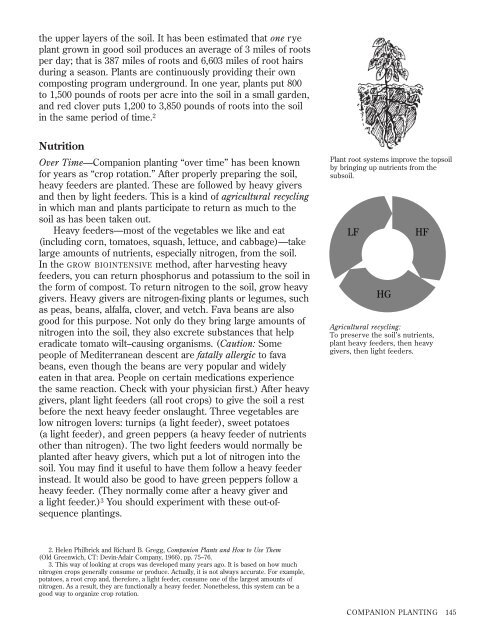How to Grow More Vegetables : And Fruits, Nuts ... - Shroomery
How to Grow More Vegetables : And Fruits, Nuts ... - Shroomery
How to Grow More Vegetables : And Fruits, Nuts ... - Shroomery
Create successful ePaper yourself
Turn your PDF publications into a flip-book with our unique Google optimized e-Paper software.
the upper layers of the soil. It has been estimated that one rye<br />
plant grown in good soil produces an average of 3 miles of roots<br />
per day; that is 387 miles of roots and 6,603 miles of root hairs<br />
during a season. Plants are continuously providing their own<br />
composting program underground. In one year, plants put 800<br />
<strong>to</strong> 1,500 pounds of roots per acre in<strong>to</strong> the soil in a small garden,<br />
and red clover puts 1,200 <strong>to</strong> 3,850 pounds of roots in<strong>to</strong> the soil<br />
in the same period of time. 2<br />
Nutrition<br />
Over Time—Companion planting “over time” has been known<br />
for years as “crop rotation.” After properly preparing the soil,<br />
heavy feeders are planted. These are followed by heavy givers<br />
and then by light feeders. This is a kind of agricultural recycling<br />
in which man and plants participate <strong>to</strong> return as much <strong>to</strong> the<br />
soil as has been taken out.<br />
Heavy feeders—most of the vegetables we like and eat<br />
(including corn, <strong>to</strong>ma<strong>to</strong>es, squash, lettuce, and cabbage)—take<br />
large amounts of nutrients, especially nitrogen, from the soil.<br />
In the GROW BIOINTENSIVE method, after harvesting heavy<br />
feeders, you can return phosphorus and potassium <strong>to</strong> the soil in<br />
the form of compost. To return nitrogen <strong>to</strong> the soil, grow heavy<br />
givers. Heavy givers are nitrogen-fixing plants or legumes, such<br />
as peas, beans, alfalfa, clover, and vetch. Fava beans are also<br />
good for this purpose. Not only do they bring large amounts of<br />
nitrogen in<strong>to</strong> the soil, they also excrete substances that help<br />
eradicate <strong>to</strong>ma<strong>to</strong> wilt–causing organisms. (Caution: Some<br />
people of Mediterranean descent are fatally allergic <strong>to</strong> fava<br />
beans, even though the beans are very popular and widely<br />
eaten in that area. People on certain medications experience<br />
the same reaction. Check with your physician first.) After heavy<br />
givers, plant light feeders (all root crops) <strong>to</strong> give the soil a rest<br />
before the next heavy feeder onslaught. Three vegetables are<br />
low nitrogen lovers: turnips (a light feeder), sweet pota<strong>to</strong>es<br />
(a light feeder), and green peppers (a heavy feeder of nutrients<br />
other than nitrogen). The two light feeders would normally be<br />
planted after heavy givers, which put a lot of nitrogen in<strong>to</strong> the<br />
soil. You may find it useful <strong>to</strong> have them follow a heavy feeder<br />
instead. It would also be good <strong>to</strong> have green peppers follow a<br />
heavy feeder. (They normally come after a heavy giver and<br />
a light feeder.) 3 You should experiment with these out-ofsequence<br />
plantings.<br />
2. Helen Philbrick and Richard B. Gregg, Companion Plants and <strong>How</strong> <strong>to</strong> Use Them<br />
(Old Greenwich, CT: Devin-Adair Company, 1966), pp. 75–76.<br />
3. This way of looking at crops was developed many years ago. It is based on how much<br />
nitrogen crops generally consume or produce. Actually, it is not always accurate. For example,<br />
pota<strong>to</strong>es, a root crop and, therefore, a light feeder, consume one of the largest amounts of<br />
nitrogen. As a result, they are functionally a heavy feeder. Nonetheless, this system can be a<br />
good way <strong>to</strong> organize crop rotation.<br />
Plant root systems improve the <strong>to</strong>psoil<br />
by bringing up nutrients from the<br />
subsoil.<br />
LF HF<br />
HG<br />
Agricultural recycling:<br />
To preserve the soil’s nutrients,<br />
plant heavy feeders, then heavy<br />
givers, then light feeders.<br />
COMPANION PLANTING 145












